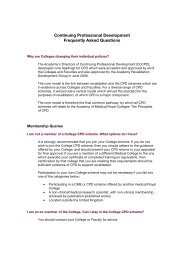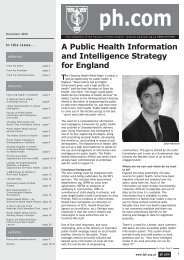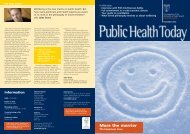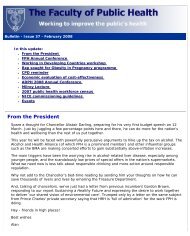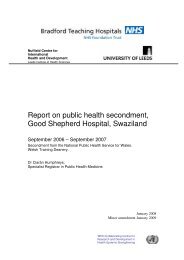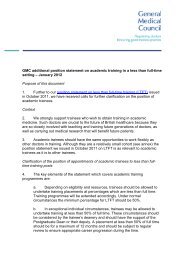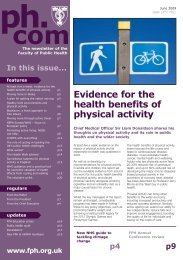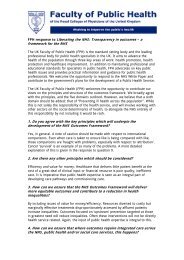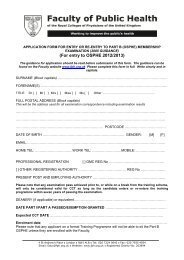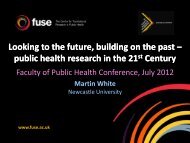A Chronology of State Medicine, Public Health, Welfare and Related ...
A Chronology of State Medicine, Public Health, Welfare and Related ...
A Chronology of State Medicine, Public Health, Welfare and Related ...
Create successful ePaper yourself
Turn your PDF publications into a flip-book with our unique Google optimized e-Paper software.
libraries <strong>and</strong> stated that access to the libraries <strong>and</strong> museums should be free <strong>of</strong> all charge.<br />
Extended to Scotl<strong>and</strong> <strong>and</strong> Irel<strong>and</strong> in 1853 (16&17 Vict., c.101).<br />
Epidemiological Society founded in London by a group <strong>of</strong> physicians, under the<br />
presidency <strong>of</strong> the Earl <strong>of</strong> Shaftesbury (see 1844), to "institute a rigid examination into the<br />
causes <strong>and</strong> conditions which influence the origin, propagation, mitigation <strong>and</strong> prevention <strong>of</strong><br />
epidemic disease, <strong>and</strong> to give advice to authorities on the best means <strong>of</strong> prevention". The first<br />
president was BG Babington (1794-1866, physician at Guy's Hospital, FRS, <strong>and</strong> later<br />
president <strong>of</strong> the Royal Medico-Chirurgical Society). Vice-presidents included John Simon<br />
(see 1848), Thomas Southwood Smith (see 1830), Thomas Addison (1793-1860, physician at<br />
Guy's Hospital) <strong>and</strong> Richard Bright (1789-1858, physician at Guy's Hospital). See 1907.<br />
Committee on the Nomenclature <strong>of</strong> Diseases set up at the Royal College <strong>of</strong> Physicians<br />
<strong>of</strong> London. The first report was published in 1869. See 1853.<br />
1850 Cont - 1852<br />
1850 cont University <strong>of</strong> London given authority to approve institutions throughout the<br />
British Empire as suitable to enter c<strong>and</strong>idates for London external degrees.<br />
1851 Census (30 March) carried out under Farr's (1839) supervision <strong>and</strong> collected more<br />
details than former censuses. The details included age, sex, occupation, birthplace,<br />
relationship to head <strong>of</strong> household, marital state, education, <strong>and</strong> the number <strong>of</strong> persons who<br />
were deaf <strong>and</strong> dumb or blind. The h<strong>and</strong>icap questions continued to be asked up to <strong>and</strong><br />
including 1911. A question about religious worship was included, the only time that this has<br />
been asked in a census. The data about education were published in a special report in 1854.<br />
The population in Engl<strong>and</strong> <strong>and</strong> Wales was given as 17.9 million, thirty five per cent aged<br />
under 15 years <strong>and</strong> four per cent aged 65 or more. For the first time more people were<br />
recorded as living in towns than in rural areas. During the 1850s one death in every three was<br />
attributed to an infectious disease, among which tuberculosis dominated.<br />
Common Lodging Houses Act (14&15 Vict., c.28) introduced registration <strong>of</strong> the<br />
keepers <strong>of</strong> common lodging houses <strong>and</strong> empowered local authorities to inspect <strong>and</strong> make<br />
regulations concerning the lodging houses. See 1853.<br />
The Labouring Classes Lodging Houses Act (14&15 Vict., c.34) authorised local<br />
authorities to establish lodging houses for the labouring classes. See 1853.<br />
Window tax repealed (14&15 Vict., c.36).<br />
The first International Sanitary Conference met in Paris to discuss the quarantine <strong>of</strong><br />
ships in respect <strong>of</strong> plague, yellow fever <strong>and</strong> cholera, but failed to produce a convention. See<br />
1892.<br />
The General Board <strong>of</strong> <strong>Health</strong> issued a statement <strong>of</strong> the duties <strong>of</strong> "<strong>of</strong>ficers <strong>of</strong> health".<br />
These included "giving instructions <strong>and</strong> directions for the removal or prevention <strong>of</strong> causes <strong>of</strong><br />
disease common to several persons, <strong>and</strong> also for the prevention or removal <strong>of</strong> causes <strong>of</strong><br />
disease to individuals, where those causes come within the province <strong>of</strong> local administration<br />
under the <strong>Public</strong> <strong>Health</strong> Act". The <strong>of</strong>ficers were required to report quarterly to the General<br />
Board <strong>of</strong> <strong>Health</strong> on the nature <strong>and</strong> amount <strong>of</strong> sickness <strong>and</strong> death which had prevailed in their<br />
areas during the quarter, <strong>and</strong> annually to provide more details about the nature, location <strong>and</strong><br />
rates <strong>of</strong> sickness <strong>and</strong> death, <strong>and</strong> possible future action for preventing identified causes. See<br />
1855.<br />
Analytical Sanitary Commission established by The Lancet to investigate the<br />
adulteration <strong>of</strong> food <strong>and</strong> drink. Reports were published in The Lancet during the next four<br />
years.<br />
Mount Street medical school, Manchester, became the medical department <strong>of</strong> Owen's



